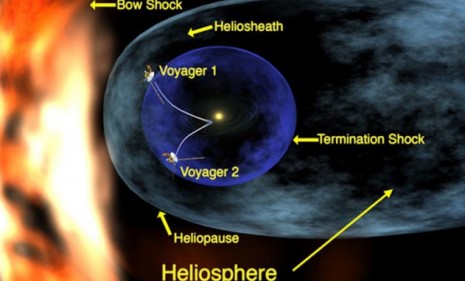Voyager 1 reaches the solar system's edge: What's next?
After 33 years of space travel, the NASA probe is set to leave the outer limits of our solar system. What else will it find?

Remember the Voyager 1? Launched in 1977, the unmanned NASA space probe has traveled nearly 11 billion miles and, having reached the outer edge of our solar system, is poised to venture into interstellar space. Although Voyager 1 has journeyed further from earth than any other spacecraft, it's still, amazingly, broadcasting data back to us. What have we learned from this probe, and what else can it teach us? (Watch a Fox News discussion about Voyager 1's mission)
Where exactly is the Voyager 1?
The craft is in the "heliosheath," one of four "onion-like layers" that mark the transition between the sun's influence (an expanse of charged particles from the sun, sometimes known as "solar wind") and interstellar space. Next it will enter the heliopause, says Pete Spotts at The Christian Science Monitor, where the solar wind "is brought to a standstill as it meets interstellar winds head-on and gets deflected sideways." Soon, the probe will move into interstellar space.
The Week
Escape your echo chamber. Get the facts behind the news, plus analysis from multiple perspectives.

Sign up for The Week's Free Newsletters
From our morning news briefing to a weekly Good News Newsletter, get the best of The Week delivered directly to your inbox.
From our morning news briefing to a weekly Good News Newsletter, get the best of The Week delivered directly to your inbox.
How "soon" will that be?
Four to five years, approximately. When we say "soon," says Melissa Bell in The Washington Post, "we're talking about NASA time."
What has Voyager 1 found so far?
It provided NASA with the space agency's first detailed pictures of Jupiter, Saturn, and some of their moons; it also took the famous "family portrait" of our solar system, taken when the probe was about 4 billion miles away from earth in 1990. Six of the system's 8 planets are visible in the mosaic of images.
A free daily email with the biggest news stories of the day – and the best features from TheWeek.com
What could it find next?
Voyager 1 will record data about conditions in interstellar space, which is thought to be much less dense than the heliosphere. It could also help us communicate with any alien life-forms it might encounter. The probe has been fitted with the Golden Record, a disc with a "variety of natural sounds"; "musical selections from different culture and eras"; and "spoken greetings from Earth-people in fifty-five languages." You can hear excerpts from it here. Unfortunately, Voyager 1 is no longer able to take photographs.
When will Voyager 1's journey end?
When its batteries run out. It's estimated that Voyager 1 has enough power to send signals back to Earth until around 2025, but its primary scientific instruments will begin shutting down in 2020. It's remarkable, however, says Nick Carbone at Time, that we are still receiving new data from this relic of the 1970s. It's "a 33-year-old dog that's still learning new tricks. If only our terrestrial technology had that sort of lifespan."
Sources: NASA, Time, Washington Post, BBC, NPR
-
 Critics’ choice: The year’s top 10 movies
Critics’ choice: The year’s top 10 moviesFeature ‘One Battle After Another’ and ‘It Was Just an Accident’ stand out
-
 The small Caribbean island courting crypto billions
The small Caribbean island courting crypto billionsUnder the Radar Crypto mogul Olivier Janssens plans to create a libertarian utopia on Nevis
-
 Political cartoons for December 21
Political cartoons for December 21Cartoons Sunday’s political cartoons include Christmas movies, AI sermons, and more